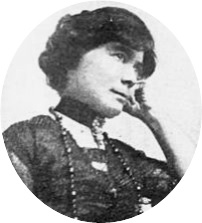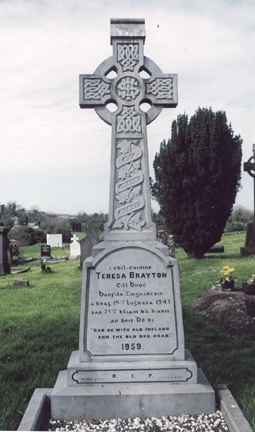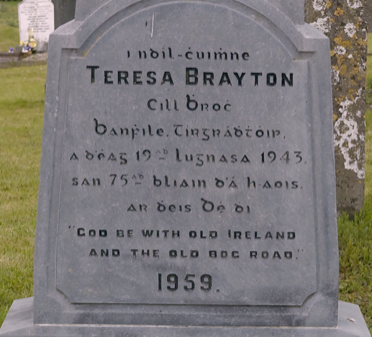Teresa Cora Boylan Brayton (1868 – 1943)
Irish Nationalist, Writer and Poet.
 Teresa
Cora Boylan was born in Kilbrook, Kilcock Co. Kildare on
June 29, 1868, to Hugh Boylan and his wife Elizabeth Boylan
(nee Downes). The Boylan's were committed Irish Republicans
with a family history dating back to the 1798 Uprising.
Teresa
Cora Boylan was born in Kilbrook, Kilcock Co. Kildare on
June 29, 1868, to Hugh Boylan and his wife Elizabeth Boylan
(nee Downes). The Boylan's were committed Irish Republicans
with a family history dating back to the 1798 Uprising.
Teresa great grandfather was a member of a United Irishmen's
contingent of pikemen who successfully attacked the British
garrison in Prosperous Co. Kildare on May 24, at the onset
of the 1798 Uprising.
As a teenager she lived through the turbulent years of
agrarian agitation, a period of civil unrest between 1879
and 1882 commonly referred to as the 'Land War' years. The
organization leading the agitation was the Irish National
Land League founded in 1879 by
Michael Davitt,
Charles Stewart Parnell, Andrew Kettle and Thomas Brennan.
The aim of the organization was to abolish landlordism in
Ireland and help the tenant farmers, who toiled the land, to
own the land.
As a result of her own observations and her family's long
history of vocal and physical resistance to British rule in
Ireland, Teresa was, from an early age, well versed in
Ireland's centuries long quest for freedom, a quest she
embraced and pursued throughout her life.
Teresa received her primary education at the Newtown
National School. She was a gifted student who won a literary
award at the age of twelve. Regarding her secondary
education the Intermediate Education Act of 1878 made
education more widely available, particularly for girls.
There is no readily available account as to where she
received her secondary or tertiary education, nonetheless,
it’s evident, based on her lifelong literary achievements,
that she possessed an intellect and worldly erudition
commensurate with that of her literary peers who received a
university education.
After completing her schooling, she became an assistant
teacher to her sister Elizabeth at the Newtown National
School, a position she held until her departure to the
United States. During the years that she dedicated to
teaching she also penned patriotic poetry and articles that
were published in The Nation and other
newspapers under the pseudonym TB. Kilbrook. In that
respect she was a member of an elite cadre of women writers
and poets that included such notables as Mary
Anne O'Doherty (Eva of the Nation), Jane Francesca
Agnes (Speranza) and
Fanny Parnell (Aleria)
who, in their time, also penned patriotic poems and
anti-British articles that, likewise, were published in
'The Nation'.
In 1895 Michael Davitt entered the House of Commons, Oscar
Wilde was imprisoned on homosexuality charges, Tipperary
were the all-Ireland Hurling and Football Champions and
Teresa emigrated to the United States, perhaps, discouraged
with the state of affairs in Ireland and/or desirous to
pursue her literary career in a less confining environment.
Her port-of-call in the United States was Boston where she
resided for a period of time before relocating to New York.
Other than for her submission of poems and articles to
newspapers and periodicals there is little evidence of what
else she did for a living. It’s quite possible that she
resumed her teaching career. While living in New York she
met and married Henry Brayton, a native of Denver, Colorado.
She was a frequent visitor to Ireland. The following
information taken from the Registration of Americans
Citizens forms filed at the United States Consulate in
Ireland in 1914 indicates, that at that time, she was
widowed.
Mrs. Teresa Brayton born 1868-06-29 at Co Kildare, spouse
Henry Brayton born at Denver, CO now deceased, arrived in
Dublin June 1914 touring.
It was under her married name of Teresa Brayton that she
became known as a poet and writer in Irish American
circles. Her poems appeared in The Irish World, New
York, The San Francisco Monitor, The Syracuse Sun, and
many other publications.
Her best-known poem 'The Old Bog Road '
is included in her book of poetry called Songs of the
Dawn published in 1913. The poem was set to music
by Madeline King O’Farrelly. The Bog Road that inspired the
poem is located midway between Kilcock and Enfield on R148
(1)
Her life in New York is not very well documented, however,
what is known is that she was very much involved in the
Irish Freedom movement. She shunned the limelight preferring
instead to work behind the scenes, but most of all and
through her poetry and writings.
The dominant Irish Nationalist and Republican organizations
in the United States in the early 1900's included The
United Irish League of America, Clan na Gael, Cumann na mBan,
the Irish Progressive League, the Friends of Irish Freedom,
and the American Association for the Recognition of
the Irish Republic. Which of these organizations she
subscribed too is unknown -- what is known is that she
worked closely with individuals who were either leaders,
members or in some way associated with these organizations
including such notables as
John Devoy,
Dr. Gertrude Kelly,
Peter Golden,
Liam Mellows,
Harry Boland,
Constance Markievicz, Helena Moloney,
Padraic Pearse,
Nora Connolly,
Muriel and
Mary MacSwiney
and others too numerous to mention.
She also had a close association with the Carmelite friars
who were very much involved in every aspect of the Irish
Freedom movement. Their priory in Manhattan and the Bronx
were places of worship and refuge for Irish Republicans
visiting New York. Their schools and halls were available
for socials, fund raising events and memorials to the
executed Republican leaders of the Easter Rising, War of
Independence and the Civil War.
After the 1916 Rising, Constance Markievicz sent her a
letter acknowledging her contribution and also a necklace
with a sliver of the flagstaff that flew the flag of the
Irish Republic from the roof of the General Post Office in
Dublin on Easter Monday 1916. That necklace was one of her
proudest treasures that she wore with reverence for the rest
of her life.
Her published works included three books of poetry; Songs
of the Dawn published in 1913, The Flame of Ireland
in 1926 and Christmas Verses in 1934.
She returned to Ireland permanently in 1932, settling first
in Dublin and in 1940 returned to the place of her birth
where she died on August 19, 1943.
In 1959 the President of Ireland, unveiled the Celtic cross
shown below over her grave.
--------------------------------------------------------------------------------------------------
Notes:
1, The local Teresa Brayton Heritage Group has
created an Immigrants’ Garden at the top of
The
Old Bog Road
with plants and flowers mentioned by Teresa Brayton in her
nature poetry. A large, inscribed stone marks the entrance
to the road and two information panels have been erected
Contributed by Tomás Ó Coısdealbha
cemetery
NAME:
Cloncurry Cemetery
ADDRESS:
Cloncurry, Co. Kildare, Ireland
HEADSTONE AND INSCRIPTION



